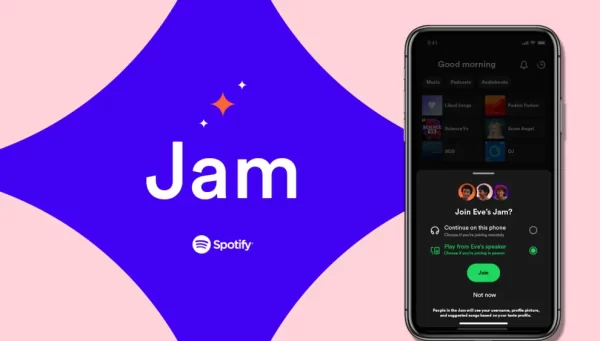
Spotify Debuts Jam
Spotify debuts its latest social feature, Jam, lets several people mix their music interests into a playlist. The new function, which relies on technologies used in Blend and Duo Mix, is designed for real-time listening at a party, where anybody may contribute to a shared queue of songs to play next.
Today, Spotify says, everyone may choose the music at a party.
Anyone can contribute to a Jam, but only Spotify Premium subscribers can create one. Tap the speaker symbol at the bottom or the three-dot menu at the top and pick “Start a Jam” from any song, album, or playlist to begin. You can choose to play music on your phone or, more likely, a speaker.
Spotify will prompt users on the same Wi-Fi network to join the Jam when they open their app.
You can directly invite users to contribute to the Jam by tapping your phones together with Bluetooth on, having a friend scan the Jam QR code from your phone, or utilizing the “share” option to send a link via social media, iMessage, SMS, and more.

As people upload songs to the shared queue, their profiles appear next to the tune. Spotify says the Jam’s private session can hold 32 people.
Being the Jam’s host means you may choose who’s in the Jam, adjust the track order, and remove songs you don’t want played. Spotify lets hosts enable “Guest controls” to let guests remove songs or reorder them. The company plans to add more features to Jams, but it wouldn’t say if a voting system to move tunes up the list would be one. Only hope!
Jam, a shared queue for group listening, also uses Spotify’s personalisation engine, making it unique.
Jam makes suggestions depending on everyone’s listening interests. Blend, a popular Spotify app feature, has created over 45 million tailored, blended playlists using this technique. Over 200 million hours of Spotify collaborative playlists have been listened to, with Gen Z listening the most.
Spotify says it has suggestion technology to manage group members with varying musical interests. Spotify says this requires several inputs and signals, but the details are part of its secret sauce and change per user and shared session.
“We are able to create great personalized recommendations because of our dynamic systems that consider a wide variety of inputs such as what you’re listening to, which songs you’re adding to your playlists, how others with similar tastes listen, and more,” explains Bryan Roy, Design Director at Spotify. “And with Jam, we have improved our recommendations to allow for more real-time listening,” he says.
Spotify is offering Jam as another reason to subscribe and pay, despite recent price hikes. In Q2 2023, the business reported 220 million subscribers, increasing 17% year-over-year. The price increases could lead to more cancellations, although the business assured investors in its most recent quarter that they will have “minimal impacts” in Q3.
All Spotify subscribers worldwide will get Jam on September 26.
The corporation may also be planning a $20-per-month HiFi tier with lossless audio, compared to $10.99 per U.S. user.
Frequently Asked Questions (FAQs) related to “Spotify Jam”;
1. What is Spotify Jam?
Spotify Jam is a new feature introduced by Spotify that allows up to 32 users to collaboratively create and edit a playlist in real-time.
2. How does Spotify Jam work?
To use Spotify Jam, a playlist owner can invite up to 32 friends or users to join the collaborative playlist. Once added, all participants can add, remove, or reorder songs in the playlist simultaneously, creating a collaborative and dynamic music experience.
3. Can anyone create a collaborative playlist with Spotify Jam?
The ability to create a collaborative playlist with Spotify Jam is available to Spotify Premium users who have the Spotify mobile app.
4. How do I start a Spotify Jam session?
To start a Spotify Jam session, a Premium user can create a playlist, tap the “Make Collaborative” option, and then invite friends to join the playlist. Once participants accept the invitation, they can collectively edit the playlist.
5. How many people can participate in a Spotify Jam session?
A Spotify Jam session can accommodate up to 32 participants, including the playlist owner.
6. Can non-Premium users join a Spotify Jam session?
Non-Premium users can be invited to a Spotify Jam session, but the playlist owner must be a Spotify Premium user.
7. Can Spotify Jam playlists be made public or shared with others outside the collaborative group?
Spotify Jam playlists can be shared with others, but the collaborative editing features are limited to the invited participants. The playlist owner can choose to make the playlist public or share it with specific users.
8. What happens if multiple participants try to edit the playlist simultaneously?
When multiple participants edit a Spotify Jam playlist at the same time, the changes are synced in real-time. This allows for seamless collaboration without conflicts.
9. Can I see who added or edited songs in a Spotify Jam playlist?
Yes, Spotify displays the profile pictures and usernames of participants who add or edit songs in a collaborative playlist, so you can see who contributed to the playlist.
10. Is Spotify Jam available on all platforms?
- As of now, Spotify Jam is available on the Spotify mobile app for Premium users. It may be expanded to other platforms in the future.
11. Are there any privacy settings for Spotify Jam playlists?
- The playlist owner has control over privacy settings and can choose to make the playlist public, private, or share it with specific users. Collaborative playlists can be as private or as open as the owner desires.
These FAQs provide insights into Spotify Jam, a collaborative playlist feature introduced by Spotify, and how users can use it to create and enjoy music with friends in real-time.

Leave a Reply